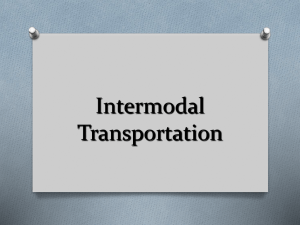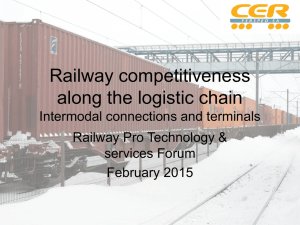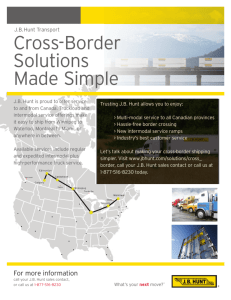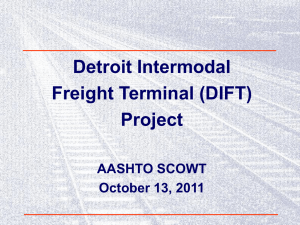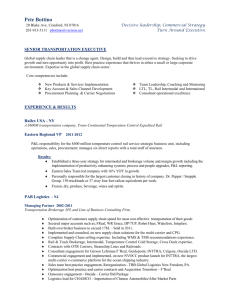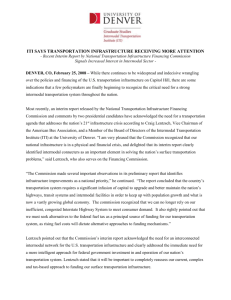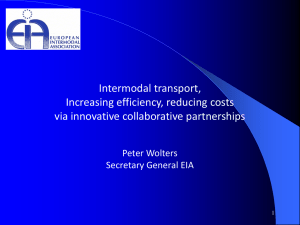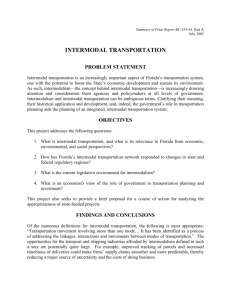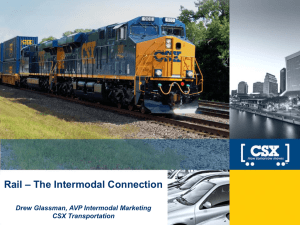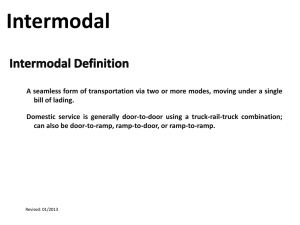Intermodal
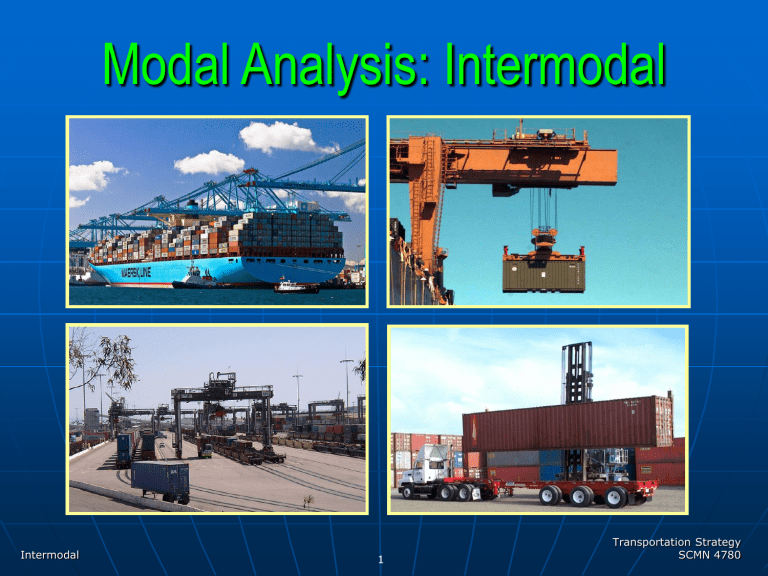
Modal Analysis: Intermodal
Intermodal
1
Transportation Strategy
SCMN 4780
Intermodal Share of US Transport Market
2010 US
Shipments
Truck
Rail
Pipeline
(TONS)
12,490 68%
1,776 10%
1,494 8%
Intermodal 1,380 8%
Water 860 5%
Air
Other
Total
12 0%
302 2%
18,313
INTERMODAL
PIPELINE
RAIL
TRUCK
Pipeline
Intermodal: transportation of freight in an multi-mode container (rail, ship, or truck) without handling the freight when changing modes.
Transportation Strategy
SCMN 4780
2
Intermodal Industry
• Intermodal transportation reduces cargo handling thereby improving security, reducing damage & loss claims and allowing freight to be transported more efficiently.
• A key benefit is lower costs vs. motor freight for intra-continental moves; downside is the marginally increased transit times vs. truck transport over short distances.
Intermodal
3
Transportation Strategy
SCMN 4780
Intermodal Industry Statistics
Intermodal
4
Transportation Strategy
SCMN 4780
Intermodal Industry Statistics
Intermodal
5
Transportation Strategy
SCMN 4780
Intermodal Containers
• Containers (or ISO containers) are the primary type of equipment used in intermodal transport, particularly when one of the modes of transportation is by ship.
• Containers are 8-foot wide by 8-foot high. The most common lengths are 20 feet, 40 feet and 53 feet although other custom lengths exist.
• In countries where the railway track gauge is sufficient, truck trailers are used. Variations exist including open-topped versions covered by a fabric curtain are used to transport larger loads.
• Containers called tanktainers (tank inside standard container frame) carry liquids. Refrigerated containers are used for perishables.
Transportation Strategy
SCMN 4780 Intermodal
6
Intermodal Industry Statistics
Intermodal
7
Transportation Strategy
SCMN 4780
Container Handling
Standardized handling equipment is designed for efficiently transferring containers between rail, truck and sea-going vessels and includes:
• Transtainers - transferring containers from sea-going vessels onto either trucks or rail wagons; a transtainer is mounted on rails with a large boom spanning the distance between the ship's cargo hold and the intermodal wagon moving parallel to the ship's side
• Gantry Cranes - straddle rail and road vehicles allowing for quick transfer of containers; a spreader beam moves in several directions allowing accurate positioning of the cargo
• Reach Stackers - fitted with lifting arms, spreader beams lift units to swap or stack containers on top of each other
• Sidelifters - over-the-road trailers with cranes fitted at each end to hoist and transport containers in small yards or over longer distances
Intermodal
8
Transportation Strategy
SCMN 4780
Intermodal Transportation - Ocean
• Ocean vessels are designed to transport intermodal containers.
• Custom-built to carriers specifications, a ships capacity is measured in
TEUs or 20’ equivalent units.
• Vessel that holds 1,000 40’ containers has a capacity of 2,000 TEU.
• Containers are typically stacked seven high.
• Large container ships are capable of carrying > 15,000 TEUs.
Transportation Strategy
SCMN 4780 Intermodal
9
Intermodal Transportation - Ocean
Intermodal
10
Transportation Strategy
SCMN 4780
Top 15 Global ISO Container Companies
Intermodal
CONTAINER COMPANY
Moller-Maersk Group
Mediterranean Shipping
CMA CGM
American President Lines
Evergreen Marine
Hapag-Lloyd
COSCO
CSAV
Hanjin Shipping
China Shipping Container Lines
NYK Line
Mitsui Lines
Orient Overseas Container Line
Hamburg Süd
Zim Integrated
TEU CAPACITY NUMBER OF SHIPS
2,150,888
1,638,962
545
414
1,100,007
589,879
554,725
541,811
384
147
152
124
498,437
469,428
448,051
440,236
365,034
363,188
353,338
338,778
322,685
134
128
98
122
95
94
77
109
96
11
Transportation Strategy
SCMN 4780
Intermodal Transportation - Rail
In the US, containers are shipped by rail on container cars. These cars resemble flatcars but have a container-sized depression (well), in the middle of the car. This depression allows for sufficient clearance to allow two containers to be loaded in the car in a "double stack" arrangement.
In the US, transporting semi-trailers on rail flatcars, an arrangement called "piggyback" or TOFC (trailer
on flatcar) is common. Flatcar design allows trailers to be rolled on from one end, though lifting trailers on and off flatcars by specialized loaders is more common. TOFC terminals typically have large areas for storing trailers pending loading or pickup.
Transportation Strategy
SCMN 4780 Intermodal
12
TOFC & COFC – High Volume Lanes
Intermodal
13
Transportation Strategy
SCMN 4780
Intermodal Transportation - Truck
Truck freight is frequently used to connect the "linehaul" ocean and rail segments of a global intermodal freight movement. This specialized trucking that runs between ocean ports, rail terminals, and inland shipping docks, is often called drayage, and is typically provided by dedicated drayage companies or by the railroads.
Transportation Strategy
SCMN 4780 Intermodal
14
Intermodal Transportation – Land Bridges
The term land bridge is used in intermodal freight with reference to a containerized ocean freight shipment that travels across a large body of land for a significant part of the trip, en-route to its final destination.
There are 2 land bridge applications:
1. Intermodal container shipped by ocean vessel from country-to-country where the land bridge crosses an entire country or continent enroute.
2. Intermodal container shipped by ocean vessel from country-to-country where freight passes across a large portion of land in either country.
Transportation Strategy
SCMN 4780 Intermodal
15
Intermodal Transportation – Load Securing
Intermodal
16
Transportation Strategy
SCMN 4780
Intermodal Transportation – Load Securing
• It is estimated 20 - 25% of freight accidents are attributable to inadequate cargo securing. Cargo improperly secured can cause accidents leading to the loss of cargo, lives, vehicles, (truck, ship, air) and can result in environmental hazards.
• There are numerous practices and materials available to stabilize and secure cargo in containers.
• Conventional load securing methods and materials such as steel banding and wood blocking & bracing are widely used.
• Recently, new methods have become available through innovation and technological advancement including polyester strapping and lashing, synthetic webbings and dunnage bags.
Transportation Strategy
SCMN 4780 Intermodal
17
Port / Container Security
Intermodal
18
Transportation Strategy
SCMN 4780
Intermodal Transportation – Security
The increased importance of global transportation presents port authorities with a challenge of how to tighten security measures. The challenge – how to protect their assets without disrupting commerce resulting in severe economic consequences?
Port security managers must be vigilant to not confuse devices designed for inventory with those meant for security.
Although some devices can serve both purposes, they should be evaluated separately for each application.
Transportation Strategy
SCMN 4780 Intermodal
19
Intermodal Transportation – Security
A multi-layered approach of low technology, new complex technology and best practices should be employed. Although difficult, it’s necessary to effectively manage and measure the deterrence of security issues.
Best security seals are difficult to tamper with mechanically and impossible to tamper with electronically.
Any attempt to open or tamper with the seal initiates an alert. It is activated upon closing and deactivated only upon it being reopened by authorized person.
Radio frequency identification tags (RFID) are claimed to be security devices. They are not but do provide tamper-indicating seals used to detect unauthorized access.
Intermodal
20
Transportation Strategy
SCMN 4780
